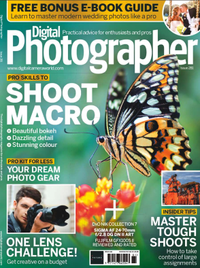"In my opinion, shooting from a lower perspective brings out the best in many photos"
Anoop Raghavan Manikkoth shares four photographic decisions for capturing detailed wildlife in atmospheric sceneries

"I love capturing action shots of wildlife subjects, especially birds, with end-to-end details in the frame. I believe this is the most difficult kind of photography, given that to produce such frames, you need to be in supreme control over your gear, its capabilities, and the settings. But I love the challenge," explains Anoop Raghavan Manikkoth.
I had the pleasure of interviewing him about his work and analyzing his image 'Toss in the meadows'. We discussed the techniques he used to capture the photo and why it works..
1. Detailed insights
"Blue-cheeked bee-eaters are migratory to this part of the world (Bhigwan, Maharashtra, India). Flying quickly in indefinite patterns, they swoop down and snatch their prey, then the bird comes back to the perch and tosses the prey before gulping it down," Anoop says. Recording parts of this process offered exhilarating challenges. "It was difficult to focus on the bird since it was perched among the flowers," he says. "Also, I had to increase the shutter speed to 1/3200sec to make sure I froze the action properly."
2. Shallow depth of field
Anoop captured the scene with a wide aperture of f/4, creating a shallow depth of field where the focus area is minimized. Consequently, both the background and foreground elements aren’t in sharp focus. "While I made sure to get crisp details on the subjects, the rest of the elements are blurred," Anoop says. "This way, the attention on the subjects remains intact but the feast of colours adds elements without being distracting within the composition."
3. Foreground interest
Moving away from the usual eye-level perspective is popular in various genres – not just wildlife, but also landscape, architecture, and action photography. "In my opinion, shooting from a lower perspective brings out the best in many frames. This perspective conveys the scene directly to the viewers," Anoop says. By going low, Anoop has created a strong relationship between the subject and the viewer. However, this angle also naturally adds a foreground element to the composition, creating further depth and interest. "The vibrant colors of the flowers are enhanced while the viewer gets the feeling of being in the meadow themselves," he adds.
4. Harmonious colors
"These flowers blossom for a month after the monsoon in this part of the world," Anoop says. "It’s mesmerizing to see the blooming Bhigwan grassland." The patches of tiny purple flowers not only add interest to the composition but also bring in a patch of color without overloading the frame. "I captured the bird tossing the insect while it was perched on a branch in the meadow. That meant I could include these vibrant colors with lots of contrast," he adds. To achieve this, he increased
the saturation levels in post-processing.
Tech details

Camera: Sony A1
Get the Digital Camera World Newsletter
The best camera deals, reviews, product advice, and unmissable photography news, direct to your inbox!
Lens: Sony FE 600mm f/4 GM OSS
Aperture: f/4
Shutter speed: 1/3200 sec
ISO: 800

A photographer originally from Kerala, India, but currently based in Dubai, UAE, Anoop primarily focuses on capturing photographs of birds. He is a brand ambassador for Wild Roar India and Leofoto Middle East, a testament to his expertise and reputation in the industry. Anoop also leads workshops, supporting aspiring photographers in the region.
Others photos in the Why Shots Work series
- Urban street photographer reveals his candid capture secrets
- Photographer tells story of getting up close and personal with a python
- Discover four key elements that make this stunning photo a success
- The 4 photographic decisions that take this motorsport shot to the next level
- Photographer tells story of his amazing shot of wallabies fighting on the beach
This article originally appeared in Digital Photographer, a monthly magazine, and the kitbag essential for pros, enthusiasts, and amateurs alike!
Inside, you'll find practical guides, shooting tips, and techniques from working photographers, plus all the latest industry news.

Kim is the Staff Writer on Digital Camera World, and formerly Technique Editor at Digital Photographer, focusing on the art and science of photography. With a Master’s degree in Photography and Media, she is driven to educate through an analytical approach, visually and technically. With her guides and tutorials, Kim seeks to uncover new facets of this time-honoured medium and foster a deeper understanding of its profound role in culture. Kim highlights topics that resonate with modern society, including women in photography and critical issues such as environmental conservation. She also discusses and reviews camera gear, giving you an overview to find the best fit for your photography journey.

